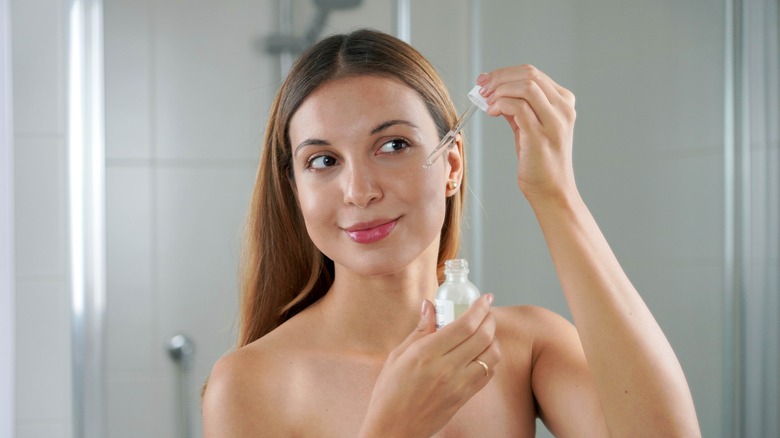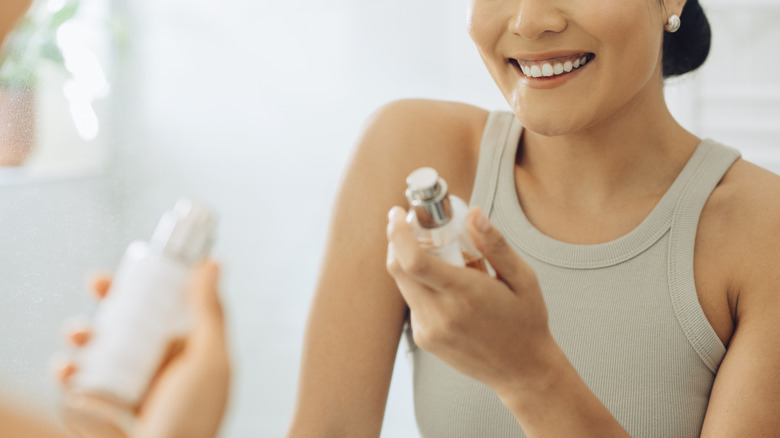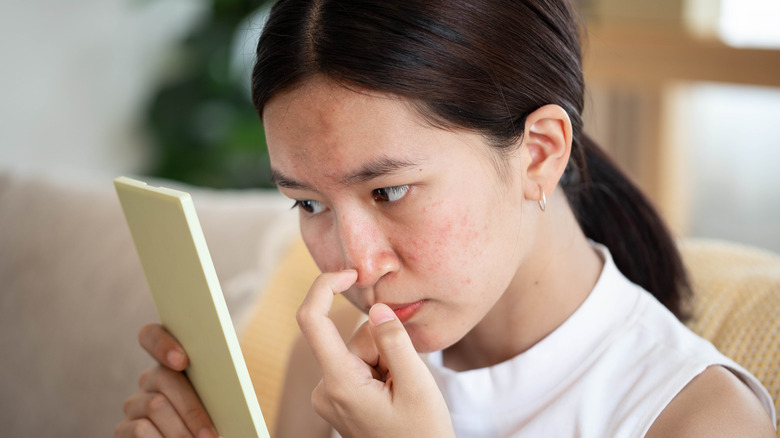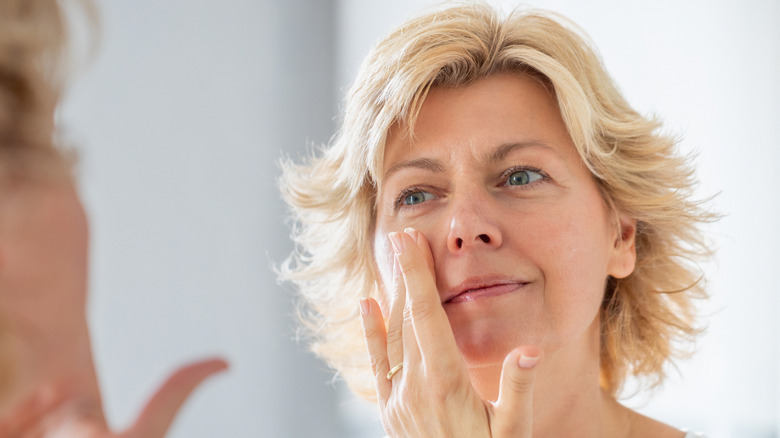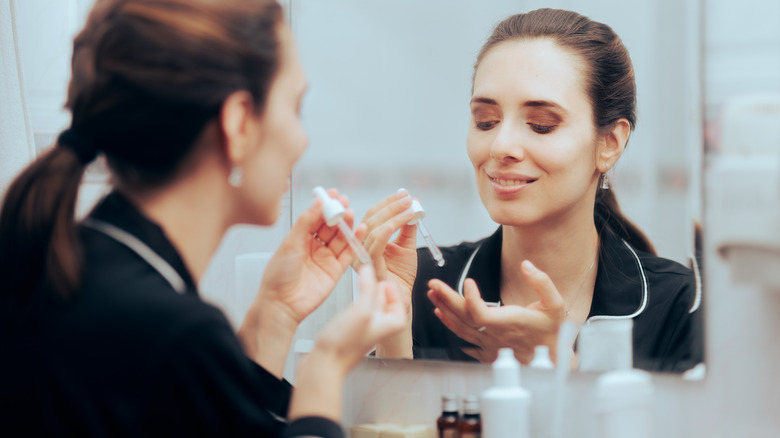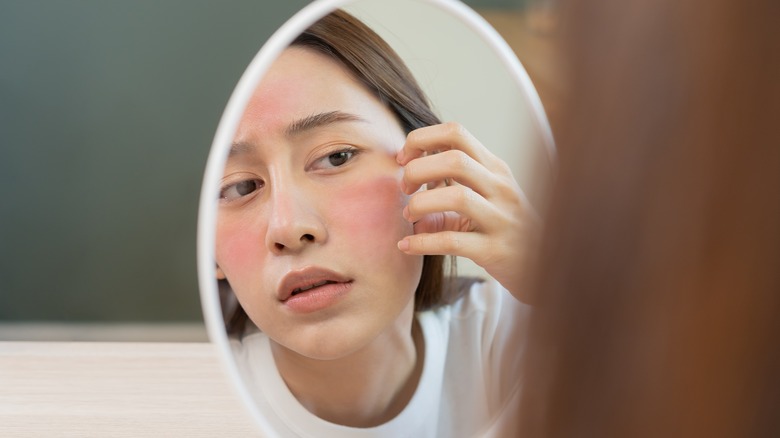How To Incorporate Retinol Into Your Skincare Routine
We may receive a commission on purchases made from links.
Social media has brought skincare concerns to the forefront of our minds, revealing issues we didn't even know existed before. Influencers have persuaded us to buy heaps of Vaseline for "slugging," jade rollers to help with drainage, and expensive lip sleeping masks that wipe off on your pillow. While these fads may work for some, there are simple dermatologist-approved ingredients that are proven to get results for many of the most common skincare concerns. One of these ingredients is retinol.
"If you're going to use one thing, it should be some form of retinoid," board-certified dermatologist and clinical associate professor Dr. Nazanin Saedi shared with Everyday Health. Retinol is a type of retinoid that can be purchased in products over the counter or can be prescribed in higher concentrations by your dermatologist. According to Cleveland Clinic, "Retinol is a form of vitamin A with many uses in skincare." However, before incorporating retinol into your routine, there are some important factors to consider.
What are the benefits of retinol?
Retinol is a versatile skincare ingredient that can help address a variety of skin concerns. "The small molecules that make up retinol go deep beneath the epidermis (outer layer of skin) to your dermis," Healthline states. These molecules fight harmful free radicals and provide anti-aging benefits such as plumping and minimizing wrinkles, fine lines, and enlarged pores.
The advantages of retinol extend beyond anti-aging properties. "Retinol, AHAs, and BHAs can help remove the top layers of the skin and promote cellular turnover," board-certified dermatologist Dr. Annie Gonzalez explained to Real Simple. "Cellular turnover reduces your risk of developing acne, and reduces the appearance of large pores, wrinkles, fine lines, and excess pigment." This increased cell turnover rate is particularly beneficial for those struggling with skin texture, acne, and scarring, as it can both minimize the appearance of these issues and prevent them from occurring altogether.
Retinol vs. retinoid
Is there a real difference between retinols and retinoids? Although the terms are often used interchangeably, they are not the same. Again, retinol is a type of retinoid. "'Retinoid' is essentially a basic umbrella term for both over-the-counter retinol and prescription retinoids," dermatologist Dr. Melissa Kanchanapoomi Levin told Byrdie. According to Healthline, "retinoid most often describes more powerful prescription products, while retinol generally refers to weaker over-the-counter (OTC) formulas." Retinols are still effective, but they may take longer to show results than stronger retinoids.
If you have severe signs of aging or acne, your dermatologist may prescribe a form of retinoid. However, many retinoids are potent, which means that their side effects can also be more extreme. Therefore, it is important to speak with a dermatologist before using them. They can ensure that the product is suitable for your condition and lifestyle, and they can also monitor the effects on your skin and discontinue use if it is causing damage.
Before you use retinol
Retinol is one of the strongest skincare ingredients available, but not everyone can handle it due to their skin type or condition. "People with sensitive skin conditions like rosacea cannot tolerate really strong topicals like retinols," board-certified dermatologist Dr. Zenovia Gabriel advised Healthline. Additionally, people with many allergies, or those who are pregnant or breastfeeding, should generally avoid such a strong ingredient. However, for most individuals, retinol is a good option. Different concentrations are available, so even those with somewhat sensitive skin can often use it in small amounts with breaks in between.
It's also important to note that you should not mix retinol with certain other types of skincare ingredients. "It is not recommended to use benzoyl peroxide and retinoids together as they can literally cancel each other out rendering them less effective," board-certified dermatologist Dr. Shari Marchbein told InStyle. Other products that don't layer well with retinol include AHAs, BHAs, and vitamin C.
Start slow and follow the sandwiching method
Given the significant impact retinol can have on your skin, it's best to start slowly when introducing it to your routine. "Start with a very small, pea-sized amount on one night, and then wait a few days to evaluate your tolerance," said dermatologist Dr. Julia Carroll while discussing retinol with Chatelaine. Even small amounts of retinol can be overwhelming for your skin initially, so it's crucial to use it only once or twice a week. Gradually increase usage based on your skin's reaction, working up to as much as every other day.
Dermatologists recommend using the sandwiching method when applying a retinoid, especially if you have sensitive skin. This process involves applying a base layer of moisturizer, then the retinol, followed by another layer of moisturizer. "Studies have shown that this base layer of moisturizer does not dilute or reduce the efficacy of the retinoid, but instead helps with tolerability," Dr. Shari Marchbein told Allure. Additionally, you should only use retinol at night, as it makes your skin more susceptible to sunburns. Applying SPF 50 or higher in the morning will also help shield you from potential issues.
Target other parts of the body
Retinol is often associated with facial skincare, but it can be used on other parts of the body as well. Our bodies are often neglected when it comes to skincare, as they are frequently covered. "Traditionally, retinols have been used for the face, but the rest of the body can also join the anti-aging fun," Dr. Andrea Schrieber advised Self. As we age, many parts of our bodies—such as the thighs, chest, and backs of our arms—begin to develop wrinkles, age spots, and dullness. Products containing retinol can be regularly applied to these areas to prevent and reverse signs of aging.
Retinol is also beneficial for those with less-than-ideal skin conditions, such as body acne. Like on the face, retinol lotions can be used on the back or chest to increase cell turnover rate and exfoliate the skin, helping to eliminate and prevent acne.
Products that include retinol
Retinol is typically included in skincare products rather than being a product in itself. It can be found in serums, creams, washes, and lotions. For the face, it is recommended to use a serum or cream in small amounts due to the face's sensitivity and exposure throughout the day. A popular retinol product for beginners is Retinol 0.5% in Squalane Serum by The Ordinary, which is affordable at less than $10. At $29.99, another popular and budget-conscious retinol product for the face is Olay Regenerist Retinol24 + Peptide Night Face Moisturizer, which was voted the best moisturizer with retinol by Healthline.
For body products that include retinol, lotions are a common and affordable option for firming and age-defying. A fan-favorite seems to be Gold Bond's Age Renew Retinol Overnight Body & Face Lotion, which has 4.5 stars on Amazon. For body acne, Nécessaire's The Body Wash – With Niacinamide, Vitamins + Plant Surfactants is a popular product choice for its exfoliating properties and fast-acting power.
Side effects of retinol
Just like with any skincare ingredient, there can be downsides to using retinol. However, for most people, these downsides are only temporary and the benefits far outweigh them. The biggest drawback for many is a temporary increase in acne – it usually gets worse before it gets better. "In the realm of acne, retinoids bring out everything clogging your pores that are hiding underneath. The combination of retinoids' ability to increase cell turnover and unclog pores with everything being brought to the surface at once can result in temporary increased breakouts," said board-certified dermatologist Dr. Alexis Stephens in a conversation with Byrdie.
Other possible side effects of retinol include peeling, redness, dry skin, and burning. These symptoms will be more extreme if you use retinol too often at first. Approach retinol slowly and steadily to minimize these effects, but also continue to use it regularly knowing these downsides likely will not last forever. The one lasting negative of retinol is increased skin sensitivity to the sun, but, once again, this can be combatted by wearing SPF daily, which is something you should be doing anyway for protection.
